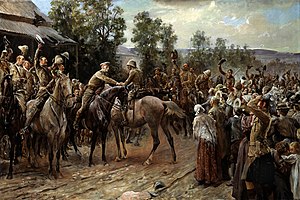Relief of Ladysmith
| Relief of Ladysmith | |||||||
|---|---|---|---|---|---|---|---|
| Part of Second Boer War | |||||||
 Major Hubert Gough of the relieving force greets General Sir George White in Ladysmith, as portrayed in a painting by John Henry Frederick Bacon. |
|||||||
|
|||||||
| Belligerents | |||||||
|
|
|
||||||
| Commanders and leaders | |||||||
| Redvers Buller |
Piet Joubert Louis Botha |
||||||
When the Second Boer War broke out on 11 October 1899, the Boers had a numeric superiority within Southern Africa. They quickly invaded the British territory and laid siege to Ladysmith, Kimberley and Mafeking. Britain meanwhile transported thousands of troops both from the United Kingdom itself and from elsewhere in the Empire and by the time the siege of Ladysmith had been lifted, had a huge numeric superiority.
The Colony of Natal was bisected from east to west by the Tugela River which rose in the Drakensberg (to the west) and flowed into the Indian Ocean to the east. The colony was bisected from north to south by the railway line that linked Durban and Johannesburg (completed 1895). The railway line crossed the river at Colenso. Downstream from Colenso the Tugela entered a gorge while upstream from Colenso the hills that overlooked the river continued on the northern bank of the river only – the southern bank was a relatively flat plain many kilometres wide.
Ladysmith lies on the Durban–Johannesburg railway line in a hollow on the Klip River some 20 km north of Colenso (as the crow flies).
When the Second Boer War broke out the Boer forces had 21,000 men under the command of General Piet Joubert ready to invade the Colony of Natal. Ranged against them, the British had 13,000 men under the command of Lieutenant General Sir George White.
The Boers crossed the border into the Colony and after battles at Talana Hill, Elandalaagte and the surrender of a large number of British troops at Nicholsons Nek, White set about defending his position at Ladysmith, some 20 km north of the Tugela river. Churchill asserts that the British Government plan, to which he became privy in later life, was for White to fall back to a position south of the Tugela River.
...
Wikipedia
